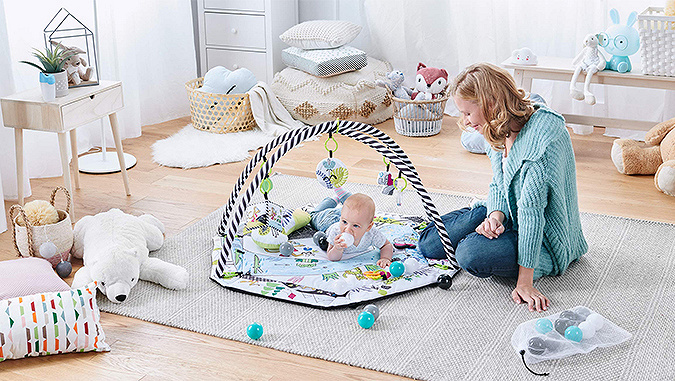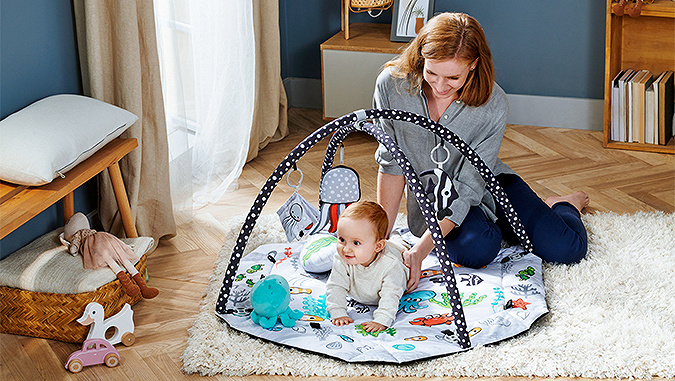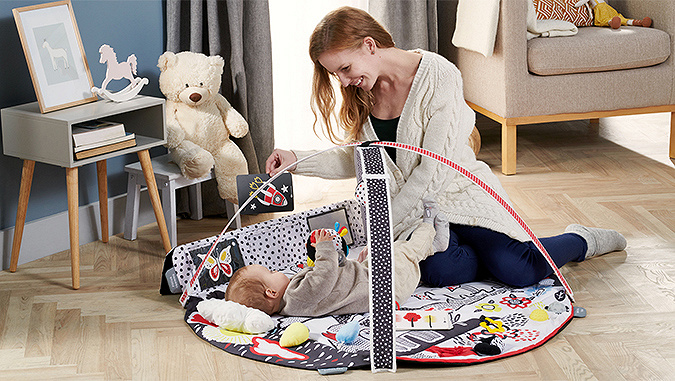Interactive toys for kids
6 min

When searching for a new toy for your child, the same problem often arises - what exactly to buy? Toys that will make your baby smile and at the same time will support their development are always a good option. Toys which by playing, moving or talking, stimulate the senses of the child and support their development are interactive.
An interactive toy, what does it mean?
Interactive toys for children are those that entertain and teach. They entertain because they shine, play, vibrate and even talk, which attracts children's attention for a long time and puts a smile on their faces. On the other hand, they teach because the interaction between a child and a toy leads to learning a new skill or developing an existing one. Interactive toys work in such a way that the toddler presses them, hits them with a toy hammer, hugs them or in any other way comes into contact with them and they react - buzzing, playing, lighting up or talking. The range of functions of this type of equipment is impressively wide.
What do interactive toys teach?
By coming into contact with a toy, a child first learns the principle of cause and effect. This is a first step to stimulate the senses: sight, hearing and touch. More complex interactive toys will develop concentration, memory, imagination and even creative problem solving skills. Younger children can exercise their muscles through interaction with toys, such as reaching out and squeezing a hand on a toy, while older children can learn new skills such as expanding their vocabulary or practicing a foreign language.
By interacting with interactive toys, a child can develop almost as many skills as there are types of such accessories. A toddler will successfully get acquainted with colors, numbers, letters, but also with animal voices and sounds of various equipment, and even with the most famous songs of great composers. The only limitation is the imagination of the manufacturers, and believe it or not but this one is very vivid.
The received stimuli make the toddler more eager to come into various kinds of contact - they will simply be more active and curious about the world. Physical stimulation pushes children to develop both manual and motor skills: crawling and walking.

What to consider when choosing interactive toys for children?
It's easy to see that the range of interactive toys for kids is extremely wide - just go to any toy store. Many parents wonder as they browse through the shelves: how do I choose a perfect interactive toy for my child? There are a number of things to consider to make this a success. Here's a quick guide.
First: it's important to adjust a toy to the age of the toddler. Too young a child will be easily discouraged by too ambitious equipment, while an older child will not enjoy too simple functions. Therefore, first, pay attention to the manufacturer's labels suggesting the age for which the toy will be most suitable. Remember that these labels are estimates and each child develops individually - so be sure to judge for yourself whether your child is ready for a given product.
Second: Functions. Think about what child's sense or skill you would like to support. Motor skills? Or perhaps concentration? Sight? Or maybe hearing? Some toys only offer one type of response, but there are many more that offer a whole range of stimuli. An example of such a multifunctional toy is our 4SMART Mat, which has 4 separate learning zones. In each of them different cognitive sphere is stimulated: hearing (also by means of rustling elements), touch (by means of various textures and sensory ball), sight (for example thanks to contrasting colors) and concentration, remembering details and creative thinking (thanks to 12 contrasting cards which you can store on the side of the mat or take with you on a walk).
Also consider what toys your child already has, and try not to duplicate similar features. Some toys "grow" with your baby because they offer different levels of difficulty or can be folded and unfolded to provide new experiences. This makes them suitable for both infants and older children. When deciding on a function, it is good to take into account the personal preferences of a toddler. Maybe the toddler is fascinated with cooking or cleaning? Maybe they love cars or dolls? There is a suitable toy for every toddler!
Third: quality. It's worth paying attention to how the toy was made - did the manufacturer use high-quality materials in its production, was it carefully finished to avoid sharp edges, for example, was attention paid to details, or maybe you can see flaws and imperfections at first glance? These have a direct bearing on the safety of the toy - and safety is the key after all!
Fourth, but most importantly: safety. You can find out a lot about it by checking if and what certificates the product you are looking at has. The basis is the CE certificate, which certifies that the toy complies with European standards. The Institute of Mother and Child and the Polish Centre for Testing and Certification also issue their own certificates. On the packaging of some toys there are also warnings, usually informing that the toys are not suitable for a certain age group, or that they should be used only under adult supervision. The substances used in the manufacturing process are also a safety issue. Good toys should not contain any toxic substances, such as formaldehydes.
Also, take care of your eyes and ears, both your own and your child's. The volume of some toys can be surprisingly high, and some sounds are extremely irritating. That's why you should choose toys with a volume control and an OFF function. Check the quality of the recordings so they don't frighten or disturb. Also, excessively flashy colors or lights that change too quickly can cause concentration problems and lead to overstimulation and irritability. Especially when such devices are turned on continuously.

An interactive toy for a first birthday party. What functions should it have?
Choosing a toy for a one-year-old child is quite a challenge. Such a baby will not be satisfied with just any rattle, but at the same time is still too little for much more ambitious games. Remember, however, that when a baby is one year old, they understand us very well and the best fun for them is imitating adults. Children at this age are mainly focused on observation and are interested in everything that happens around them. They need constant stimulation and interactive toys are perfect for this, especially those that support the senses of sight, hearing and motor coordination. Any toy with a music box, colourful buttons that make sounds, training their motor skills or imagination will do just fine - you'll find them in our 4Smart mat, especially the sensory ball included in the set. It encourages children to play with its colors, engaging buttons and attractive patterns. It is also versatile - it can be part of a whole set, but also works well as a standalone toy.
Interactive toys for girls and boys. Which ones to choose?
At this age, it is not necessary to differentiate toys for boys and girls. Children of both sexes can play with exactly the same thing. A girl will be happy to ride on a rocking horse or in an interactive car that makes various sounds. A boy, on the other hand, will enjoy playing with a colourful kitchen or spend a long time playing with a teddy bear which can make sounds. Most toys for kids this age are versatile, so don't take away the opportunity for your little ones to explore the whole spectrum of entertainment. The most important function of an interactive toy isn't to fit in with the gender markers, but to keep the little explorer interested - whether a girl decides to play with an interactive excavator or a boy with a talking doll.
